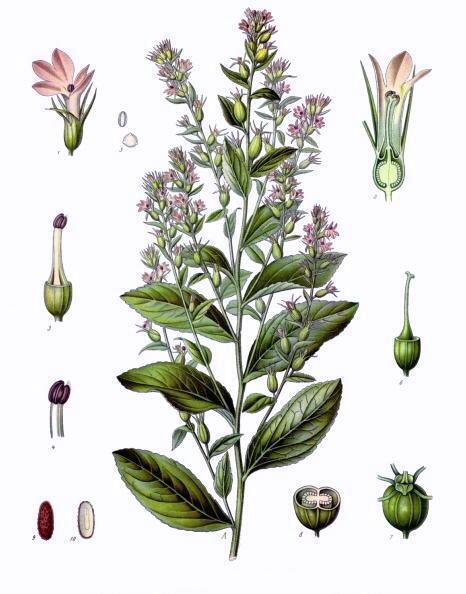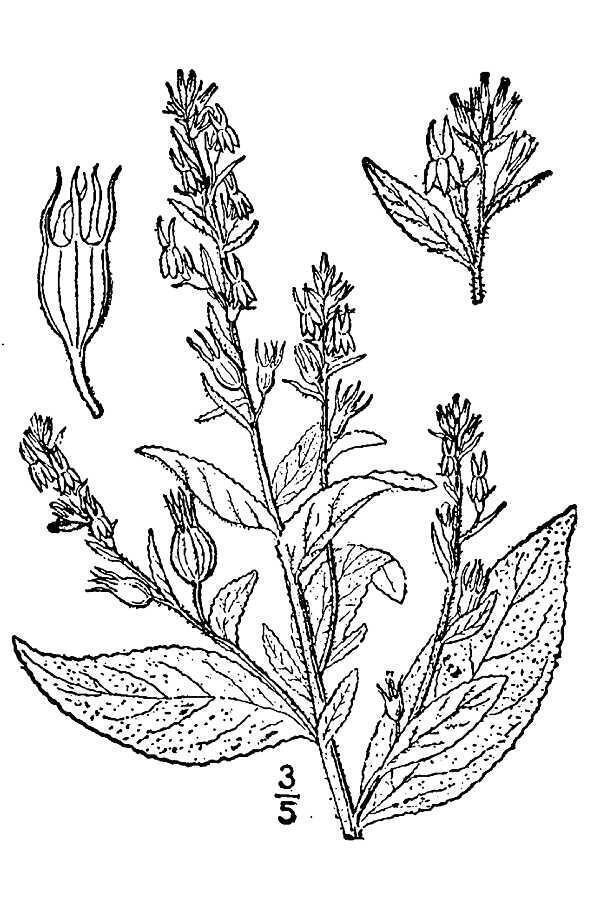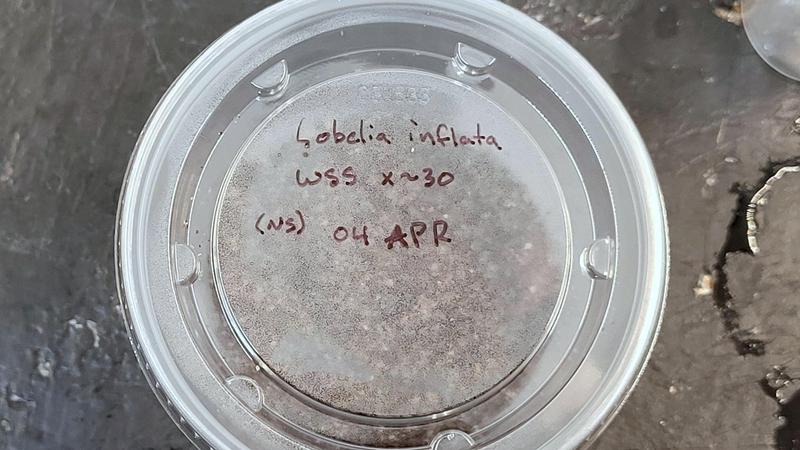Lobelia inflata
Propagation
Autogamous.[1]
Reproduction is terminal (semelparous).[1] However, some remnants of nonsemelparous behavior remain as rare secondary reproduction.[2]
Flowering occurs when the photoperiod drops below 15 h.[1]
Germination
| media | germination | temperature °C | note | reference |
|---|---|---|---|---|
Vegetative
In-Vitro
| basal media | supplements | source | target | note | reference |
|---|---|---|---|---|---|
Cultivation
Snowpack is crucial for overwinter survival of wild inflata. The snow provides insulation that reduces ground temperature variation enough to increase the survival rate from 11% in noncovered plants to 81%.[3]
| Planting density (m-2) | inter-row space (m) | intra-row space (m) |
|---|---|---|
| 6 | 0.6 | 0.3[4] |
| 9-13 | 0.25 | 0.3-0.45[2] |
Harvest
Inflata are generally harvested at full flowering phenophase.[2]
Yield
| product | source | yield per season (kg/ha) | reference |
|---|---|---|---|
| biomass | fresh | 2860 | [4] |
| biomass | dry | 1908 | [4] |
| lobeline | biomass | 19 | [4] |
| biomass | dry | 1100 | [2] |
| product | source | yield per plant | reference |
|---|---|---|---|
| biomass | wet weight | 1.49-53.0 g | [4] |
| seed capsule | 5-129 pieces | [4] | |
| seeds | capsules | 1235-52761 pieces | [4] |
| capsules | 8.18-29.66% w/w | [4] | |
| biomass | dry weight | 3.51-6.9 g | [5] |
| alkaloid | biomass | 14.2-29.1 mg | [5] |
| lobeline | biomass | 8.21-25.0 mg | [5] |
On average, the lobeline content of cultivated plants is higher than wild plants and less variable. Though the single plant with the highest lobeline content was wild.[4]
Lobeline concentration tends to decrease with maturity (from 1.95% to 0.76%), however total lobeline yield increases due to the greater accumulation of biomass.[6]
Tetraploid inflata (produced with colchicine) has considerably more lobeline content than diploid plants, though the total production of lobeline is less due to their small stature.[7]
Soilless
Soil
| soil type | pH | C-content % | precipitation | temperature (°C) | altitude (m) | note | reference |
|---|---|---|---|---|---|---|---|
Fertilization
| type | rate | time | reference |
|---|---|---|---|
| NH4NO3 | 50 kg/ha (N-basis; 34%) | prior to transplant | [5] |
| NH4NO3 | 100 kg/ha (N-basis; 34%) | prior to transplant | [5] |
| MgSO4 1 | 50 kg/ha (Mg-basis; 2%) | prior to transplant | [5] |
| MgSO4 | 50 kg/ha (Mg-basis; 2%) | prior to transplant | [5] |
Fertilization is not related to lobeline concentration. Phosphorus and ammonium sulfate provide the greatest increase in biomass. However, this may be an artifact of the large natural variation in lobeline content.[6][8] Other studies have shown that nitrogen and magnesium fertilizers positively impact both lobeline concentration and dry biomass of inflata, though total lobeline and alkaloid production per plant is not significantly related to fertilization.[5] 2 3
Temperature
Lighting
| fixture type | photoperiod | illumination | note | reference |
|---|---|---|---|---|
Pests
Ecology
Morphology
| character | measurement | unit | notes | reference |
|---|---|---|---|---|


Lobelia comprises ca. 360-400 mainly tropical species.[2]
Inflata has a high genetic variance in wild populations, inconsistent with its obligate self-fertilizing nature.[1]
Wild inflata are most often found in acidic soils from pH 4.1 to 5.8.[9]
Inflata is the only semelparous species of Lobelia.[2]
Roots
Stem
Leaves
Leaves are 2.5-7.5 cm long, sessile or sub-sessile and toothed, ovate-oblong to oblong-obovate.[2]
Inflorescence
The seed’s capsules inflate upon ripening, hence the specific epithet “inflata”. This phenomenon is unique among Lobelia.[2]
Seeds
Phytochemistry
| compound | source | concentration (mg/g dry weight) | citation |
|---|---|---|---|
| lobeline | cultivated biomass | 1.05 (3.6-22.5) | [4] |
| lobeline | wild biomass | 0.65 (0.19-23.8) | [4] |
| lobeline | juvenile biomass | 19.5 (8.9-42.8) | [6] |
| lobeline | adolescent biomass | 14.6 (4.6-28.2) | [6] |
| lobeline | mature biomass | 7.6 (6.7-9.8) | [6] |
| lobeline | stems | 5.8 (3.8-9.0) | [6] |
| lobeline | leaves | 3.8 (2.0-6.9) | [6] |
| lobeline | flower | 30.3 (13.4-59.5) | [6] |
| total alkaloid | biomass | 3.62-4.90 | [5] |
| lobeline 4 | biomass | 2.34-4.45 | [5] |
Lobeline, a piperidine/pyridine alkaloid, is the greatest single constituent of inflata alkaloids.[5][2]
The average lobeline content of the flowers is 3.03%. The stems and leaves are significantly lower, 0.58% and 0.38%, respectively.[6]
Infraspecific Variation
Biosynthesis
Distribution
Timecourse
Improvement
| trait | improvement status | reference |
|---|---|---|
Identification
| variety | description | reference |
|---|---|---|
Inheritance
Methods
| type | note | reference |
|---|---|---|
History & Society
Work Log
04 Apr 2022
30 Apr 2022
Notes
Bibliography
- K. Côté and A. M. Simons, “Genotype-Environment Interaction and the Maintenance of Genetic Variation: An Empirical Study of Lobelia Inflata (Campanulaceae),” Royal Society Open Science, vol. 7, no. 3, p. 191720, 2020.
doi: 10.1098/rsos.191720.
High levels of genetic variation are often observed in natural populations, suggesting the action of processes such as frequency-dependent selection, heterozygote advantage and variable selection. However, the maintenance of genetic variation in fitness-related traits remains incompletely explained. The extent of genetic variation in obligately self-fertilizing populations of Lobelia inflata (Campanulaceae L.) strongly implies balancing selection. Lobelia inflata thus offers an exceptional opportunity for an empirical test of genotype-environment interaction (G × E) as a variance-maintaining mechanism under fluctuating selection: L. inflata is monocarpic and reproduces only by seed, facilitating assessment of lifetime fitness; genome-wide homozygosity precludes some mechanisms of balancing selection, and microsatellites are, in effect, genotypic lineage markers. Here, we find support for the temporal G × E hypothesis using a manipulated space-for-time approach across four environments: a field environment, an outdoor experimental plot and two differing growth-chamber environments. High genetic variance was confirmed: 83 field-collected individuals consisted of 45 distinct microsatellite lineages with, on average, 4.5 alleles per locus. Rank-order fitness, measured as lifetime fruit production in 16 replicated multilocus genotypes, changed significantly across environments. Phenotypic differences among microsatellite lineages were detected. Results thus support the G × E hypothesis in principle. However, the evaluation of the effect size of this mechanism and fitness effects of life-history traits will require a long-term study of fluctuating selection on labelled genotypes in the field.
- Á. Máthé, “Indian Tobacco (Lobelia Inflata L.),” in Medicinal and Aromatic Plants of North America, Á. Máthé, Ed. Cham: Springer International Publishing, 2020, pp. 159–186.
doi: 10.1007/978-3-030-44930-8_7.
Lobelia inflata, this old species of the New World, has retained its importance as a resource of chemical compounds suitable to treat various maladies. The herb lobelia originally used by Native Americans in the New England region was subsequently popularized by Samuel Thomson (1769–1843). Its English name, “Indian tobacco”, refers to the saga according to which the dried leaves of Lobelia inflata were originally smoked by native Americans (Penobscot tribes), in the New England region, as an alternative/substitute to tobacco. The genus Lobelia comprises ca. 360–400 species, with a sub-cosmopolitan distribution. Lobelia inflata L. is native to several states of North America. It is found in open woods or occasionally in gardens, as weed, from the West Coast to Minnesota, south to Georgia and Mississippi. Lobelia inflata has a milky sap containing piperidine/pyridine alkaloids that suffuse all parts of the plant. The alkaloid fraction is rich in piperidine alkaloids and has a great potential for the treatment of disorders of the Central Nervous System. In addition, they have demonstrated antitumor and anti-inflammatory activities. Biological and chemical studies of Lobelia inflata alkaloids and, in particular, (–)-lobeline, have increased over the last few years. Lobeline might serve as a useful lead for the development of new therapeutic agents that act on nAChR (nicotinic acetyl-choline receptors) in a novel fashion.Lobelia inflata from open field production. Most of the commercially available crude drugs is sourced from either wild populations, or take their origin from imports (India and China being the main exporting countries). Recently, (Máthé et al. Introduction of Lobelia inflata L. to hungary: performance of in vitro and generatively propagated plants. In: 2006 Abstracts 27th international horticultural congress & exhibition. August 13–19, 2006. International Society for Horticultural Science – Korean Society for Horticultural Science, Seoul, pp 88–88, 2006) studied the introduction into open field conditions of both generatively and in vitro propagated Lobelia inflata L. with special regards to mineral nutrition and alkaloid production in the course of plant development. Based on the survey of ecological requirements a simplified production protocol for field cultivation is given.
- A. M. Simons, J. M. Goulet, and K. F. Bellehumeur, “The Effect of Snow Depth on Overwinter Survival in Lobelia Inflata,” Oikos, vol. 119, no. 10, pp. 1685–1689, 2010.
doi: 10.1111/j.1600-0706.2010.18515.x.
The snowpack in high altitude and latitude regions provides thermal insulation during the cold season. Recent climate change has resulted in a decrease in both the duration and the reliability of this snowpack and may thus affect overwinter survival of biota. Here we use a manipulation approach to ask how snow depth affects ground surface temperatures and how this in turn affects survival of the overwintering rosette stage in the monocarpic plant Lobelia inflata. A shallow but consistent insulation layer (R-value of 3) was sufficient to reduce temperature fluctuations and the accumulation of sub-zero degree-days substantially. For all treatments >R3 these measures were negligible. Survival results are consistent with a crucial role of thermal insulation to successful overwintering of Lobelia inflata rosettes: without a consistent snowpack survival was low (11%); with an insulation effect of R3 or greater survival increased dramatically (81%). The winter prior to the manipulation study was characterized by an anomalous absence of snow at the onset of cold temperatures. This resulted in substantially greater accumulation of sub-zero degree-days at the soil surface and almost 100% rosette mortality in the field. This study shows that inconsistent and reduced snowpack – a prediction of climate change – will have critical effects on plant survival because of increased temperature fluctuations and extreme temperatures experienced at the soil surface.
- A. Krochmal, L. Wilken, and M. Chien, “Plant and Lobeline Harvest of Lobelia Inflata L.,” Economic Botany, vol. 26, no. 3, pp. 216–220, 1972. https://www.jstor.org/stable/4253350.
- V. J. Vojnich, “The Total Alkaloid Production of Indian Tobacco (Lobelia Inflata L.) in Open Field Conditions,” in 6th International Scientific and Expert Conference TEAM, Kecskemét, 2014, vol. 6, p. 3.
Lobelia inflata L. is a medicinally important species of the Lobeliaceae family. It is native to North America and contains numerous piperidine alkaloids. The main alkaloid is lobeline that has been used as a respiratory stimulant. The aim of our studies was to follow the total alkaloid production of L. inflata in open field conditions. The highest total alkaloid content of the herb was in the 50 kg/ha Mg treatment (490 mg/100 g). Lobeline content was higher in herb of the 50 kg/ha Mg treatment (445 µg/g). The highest biomass value of the herb was in the 100 kg/ha N treatment (6.7 g).
- A. Krochmal, L. O. Wilken, and M. M. Chien, Lobeline Content of Lobelia Inflata: Structural, Environmental and Development Effects. Northeastern Forest Experiment Station, Forest Service, U.S. Department of Agriculture, 1970.
- A. Krochmal and K. Magee, “A Population of Lobelia Inflata L.,” Castanea, vol. 36, no. 1, pp. 71–76, 1971.
https://www.jstor.org/stable/4032409.
An analysis of soils in a fallow field rich in Lobelia inflata L., and a list of associated species.
- A. Krochmal and L. O. Wilken, The Culture of Indian Tobacco (Lobelia Inflata L.). Northeastern Forest Experiment Station, Forest Service, U.S. Department of Agriculture, 1970.
S2Indian tobacco (Lobelia inflata L.) is the source of an alkaloid (lobeline) that is used in anti-smoking preparations. Because of a brisk market demand for lobelia-and a decline in the harvesting of wild plants-we have studied how to grow this wild Appalachian annual (fig. 1) as a row crop under cultivation. Our studies, begun in 1967, have continued through 1970. We have learned how to germinate the seed and grow young plants for setting out in the field, and how to care for them until harvest (fig. 2).S3.
- V. J. Vojnich, A. Máthé, E. Szőke, and Z. Csapó, “Effect of Nitrogen and Magnesium Treatments on the Production of Indian Tobacco (Lobelia Inflata L,” MENDELNET, pp. 216–227, 2012.
The aim of this project was to examine the effect of magnesium and nitrogen fertilisation on the biomass and on the alkaloid production of Lobelia inflata in Hungary. Indian tobacco (Lobelia inflata L.) is a native North American species domesticated at the University of West Hungary, Department of Botany in 2010 and 2011. The establishment of plants, propagated by in vitro and in vivo methods, was studied. Both the in vitro experiments and the examination of active substances were carried out at the University Semmelweis, Department of Pharmacognosy in Budapest. When propagated by seed L. inflata needs several months to reach the transplant stage required for planting into the open-field. The in vitro propagation method, as an alternative for large-scale production, was examined. Our observations indicated that plants propagated and acclimatised in vitro have the same characteristics as those grown from seeds.
- V. Vojnich, Á. Máthé, R. Gaál, and E. Szöke, “Effect of Mg Treatment on the Production of Indian Tobacco (Lobelia Inflata),” Acta Horticulturae, vol. 955, pp. 125–128, Aug. 2012.
doi: 10.17660/ActaHortic.2012.955.16.
Lobelia inflata is a native North-American species that seems to possess various pharmaceutically significant properties. The results indicate the favourable effects of Mg-fertilization and are in harmony with previous experiments. It has been estimated that an established population can produce some 2.5 kg/ha total alkaloids under the influence of Mg treatment.
